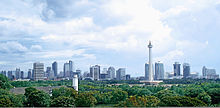Economy of Indonesia

Jakarta, the financial capital of Indonesia.
|
|
| Currency | Rupiah (IDR) |
|---|---|
| Calendar year | |
|
Trade organizations
|
APEC, WTO, G-20, IOR-ARC, RCEP, others |
| Statistics | |
| GDP |
|
| GDP rank | 16th (nominal) / 8th (PPP) |
|
GDP growth
|
5.0% (2014), 4.8% (2015), 5.1% (2016e), 5.3% (2017f) |
|
GDP per capita
|
$11,700 (PPP, 2016 est.) |
|
GDP by sector
|
agriculture: 13.7%, industry: 42.9%, services: 43.3% (2014 est.) |
| 3.02% (2016) | |
|
Population below poverty line
|
11.3% (2016) |
| 38.1 (2011) | |
|
Labour force
|
123.7 million (2016 est.) |
|
Labour force by occupation
|
Agriculture: 38.9%, industry: 22.2%, services: 47.9% (2012 est.) |
| Unemployment | 6.3% (2016) |
|
Main industries
|
Petroleum and natural gas, textiles, apparel, footwear, mining, cement, chemical fertilizers, machinery, electronics, hardware, software, telecommunications, plywood, rubber, food, tourism |
| 91st (2017) | |
| External | |
| Exports | $144.4 billion (2016) |
|
Export goods
|
Oil and gas, cement, food, electrical appliances, construction, plywood, textiles, rubber |
|
Main export partners
|
Japan 13.1% China 10% Singapore 9.5% United States 9.4% India 7% South Korea 6% Hong Kong 5.8% Malaysia 5.5% (2014 est.) |
| Imports | $135.6 billion (2016) |
|
Import goods
|
machinery and equipment, chemicals, fuels, foodstuffs |
|
Main import partners
|
China 17.2% Singapore 14.1% Japan 9.6% Malaysia 6.1% South Korea 6.7% Thailand 5.5% United States 4.6% (2014 est.) |
|
FDI stock
|
$292.8 billion (2016) |
|
Gross external debt
|
$316.1 billion (31 December 2016 est.) |
| Public finances | |
|
|
|
| Revenues | $140.8 billion (2012 est.) |
| Expenses | $160.6 billion (2012 est.) |
|
Standard & Poor's: BB+ (Domestic) BB+ (Foreign) BBB- (T&C Assessment) Outlook: Stable Moody's: Baa3 Outlook: Stable Fitch: BBB- Outlook: Positive |
|
|
Foreign reserves
|
$116.40 billion (December 2016) |
Indonesia has one of the largest economies in Southeast Asia and is one of the emerging market economies of the world. The country is also a member of G-20 major economies and classified as a newly industrialised country. It is the sixteenth largest economy in the world by nominal GDP and is the eighth largest in terms of GDP (PPP). Indonesia still depends on domestic market, and government budget spending and its ownership of state-owned enterprises (the central government owns 141 enterprises) and the administration of prices of a range of basic goods including, rice, and electricity plays a significant role in Indonesia market economy, but since the 1990s, 80 percent of the economy has been controlled by private Indonesians and foreign companies.
In the aftermath of the financial and economic crisis that began in mid-1997 the government took custody of a significant portion of private sector assets through acquisition of nonperforming bank loans and corporate assets through the debt restructuring process and the companies in custody has been sold out by privatization several years later. Since 1999 the economy has recovered and growth has accelerated to over 4–6% in recent years.
In 2012 Indonesia replaced India as the second-fastest-growing G-20 economy, behind China.
In the 1960s, the economy deteriorated drastically as a result of political instability. They had a young and inexperienced government, which resulted in severe poverty and hunger. By the time of Sukarno's downfall in the mid-1960s, the economy was in chaos with 1,000% annual inflation, shrinking export revenues, crumbling infrastructure, factories operating at minimal capacity, and negligible investment. Nevertheless, Indonesia´s post-1960 economic improvement was quite remarkable when one considers how few indigenous Indonesians in the 1950s had received a formal education under Dutch colonial policies.
...
Wikipedia
